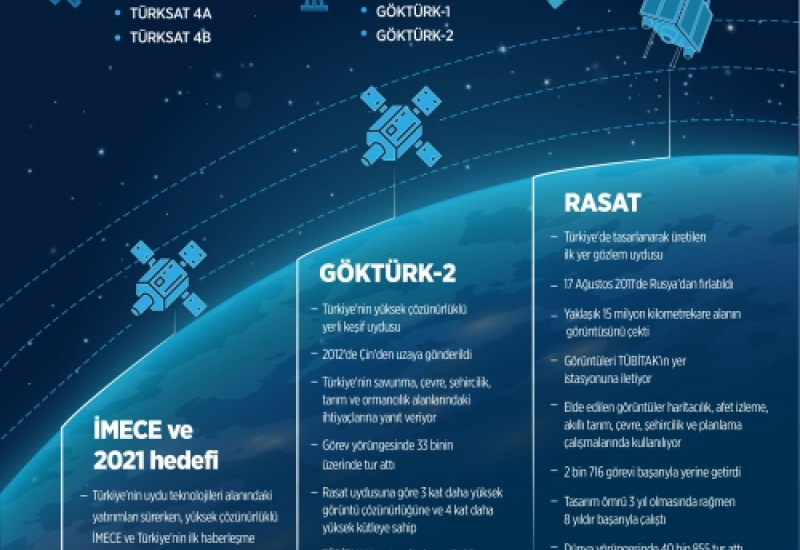Turkey, which has intensified its efforts in the field of space technologies, has a total of six active satellites. Three of them are communication satellites and the other three are earth observation satellites. While Türksat 3A, Türksat 4A and Türksat 4B satellites meet communication needs, Rasat, Göktürk-1 and Göktürk-2 satellites are used for observation purposes.
According to the information compiled by the AA, Rasat, the first earth observation satellite designed and manufactured in Turkey was launched from Russia on 17 August 2011. Rasat, which can take images from all over the world without any limitation, transmits these images to the ground station located at TÜBİTAK Space. Images obtained from Rasat are used for studies related to cartography, disaster monitoring, smart agriculture, environment, and urban planning.
During its time in space, Rasat, which has captured images totaling 14,956,200 square kilometers of area, has carried out 2,716 successful missions. Despite being designed to operate for 3 years, it has been successfully working for 8 years, and has orbited the world 40,855 times.
Rasat satellite is in synchronized circular orbit with the sun, and operates at an altitude of 700 km with a 7.5 meters black and white, 15 meters multi-band spatial resolution (pushbroom) camera.
As part of Göktürk-2 orbital mission it has orbited over 33 thousand times
Turkey’s domestic high-resolution observatory satellite Göktürk-2, was put into orbit with launch mission operations carried out in 2012.
Göktürk-2, which was manufactured through the business partnership of TÜBİTAK Space and Turkish Aerospace Industry (TUSAŞ), was sent to space from Jiquan Launch Base located in China.
Göktürk-2, which has a resolution of 2.5 meters, is fully operated by the Turkish Air Force to meet Turkey’s defense, environment, urban planning, agriculture and forestry needs.
Göktürk-2, which has completed 33 thousand orbits, is seven years old, and in comparison to the Rasat satellite, it has a resolution that is three times greater and a mass that is four times greater.
The satellite uses a domestic flight computer and software developed by TÜBİTAK Space.
The Göktürk-2 satellite, which weighs approximately 400 kilograms, has high maneuverability to offer stereo viewing possibilities that can be used to prepare 3D maps of the Earth.
Göktürk-1 meets Turkish Armed Force’s intelligence needs
Göktürk-1 satellite is among the observation satellites that provide high resolution satellite imagery for both civilian and military purposes, and which have the most advanced systems with these features.
Without any geographical restrictions, high-resolution satellite images from across the world meet the intelligence needs of the Turkish Armed Force (TSK). It was sent to space in 2006 from the Koruou Launch Base located in French Guiana.
Göktürk-1 was developed through the Turkish partnerships of TUSAŞ, ASELSAN, TÜBİTAK, National Electronics and Cryptology Research Institute, ROKETSAN, and TR TECNOLOGY, along with Thales Alenia Space, as part of the Turkish Air Force’s project.
Göktürk-1, which has a mass of approximately 1,070 kilograms without fuel, operates its high-resolution optical camera in orbit, simultaneously with the sun.
The life span of the 0.50 meter resolution camera, designed to explore any part of the world, is estimated to be seven years.
2021 target for İMECE
While in Turkey investments in the area of satellite technologies are ongoing, progress for the development of the observatory satellite called İMECE is well on its way as well.
İMECE and Türksat 6A, Turkey’s first domestically produced communication satellite, are planned to be sent into space in the year 2021.
At Airbus D&S’s facility located in France and England, the design and manufacturing operations for the Türksat 5A and Türksat 5B communication satellites are well on schedule. The Türksat 5A satellite is planned to be sent into space in 2020, whereas the Türksat 5B satellite will be sent into space in 2021.
Previously three communication satellites Türksat 1B, Türksat 1C, Türksat 2A and an observation satellite called BİLSAT were sent into space. They all have completed their operational life span.
